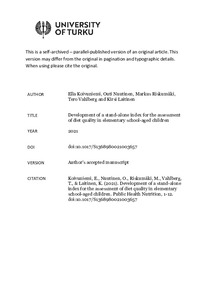Development of a stand-alone index for the assessment of diet quality in elementary school-aged children
Koivuniemi Ella; Nuutinen Outi; Riskumäki Markus; Vahlberg Tero; Laitinen Kirsi
https://urn.fi/URN:NBN:fi-fe2021093049022
Tiivistelmä
Objective: To develop and evaluate a stand-alone Elementary School-aged Children's Index of Diet Quality (ES-CIDQ).
Design: In this cross-sectional study, children filled in a food frequency questionnaire (FFQ) with twenty-nine multiple-item questions on the consumption of foods, portion sizes and eating frequency and a 5-d food diary. Nutrient intakes were calculated with nutrient analysis software. FFQ questions best reflecting a health-promoting diet with reference to dietary recommendations were identified by correlations, logistic regression modelling and receiver-operating characteristics curve analysis.
Setting: Southwest and Eastern Finland.
Participants: Healthy elementary school-aged volunteers [n 266, mean (sd) age 9·7 (1·7) years] were recruited between March 2017 and February 2018.
Results: A set of questions was identified from the FFQ that best depicted the children's diet quality as defined in the dietary recommendations. These fifteen questions were scored and formulated into a stand-alone index as a continuous index score (range 0-16·5 points) and a two-category score: good and poor diet quality. The cut-off score of six points for a good diet quality had a sensitivity of 0·60 and a specificity of 0·78. Children with a good diet quality (49·8 % of the children) had higher intakes of protein, dietary fibre, and several vitamins and minerals, and lower intakes of sucrose, total fat, SFA and cholesterol compared to children with a poor diet quality.
Conclusions: The developed short stand-alone index depicted diet quality as defined in the dietary recommendations. Thus, ES-CIDQ may be used for assessing diet quality in Finnish elementary school-aged children in school health care and nutrition research.
Kokoelmat
- Rinnakkaistallenteet [27094]
